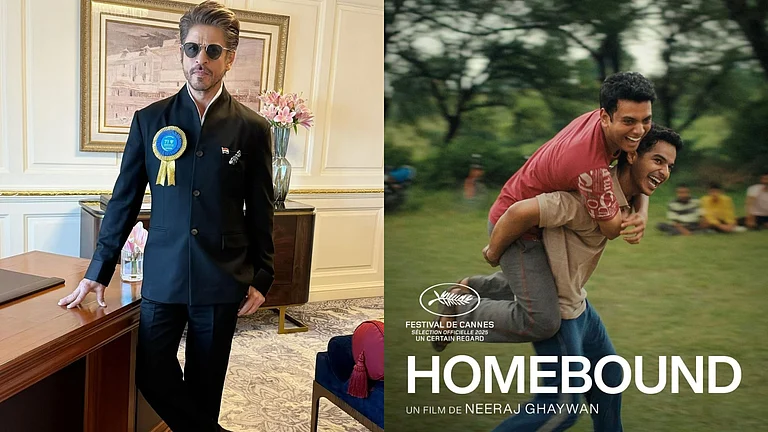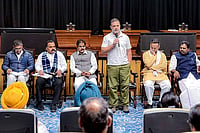
Bollywood superstar Shah Rukh Khan turns 60 on November 2, 2025.
Since Ra.One, he has submitted his body to the workings of VFX in ways perhaps not many film stars have.
If in the ’90s and 2000s, his body was the embrace in which love thrived, since the 2010s, it has become an archive of his experiments with technologies.
What does a star’s body mean to their fans, to cinema, and to the star themself? The body of a film star often exists in platitudes beyond the films they appear in—as lovers, idols, gods, and objects of sexual reverence. Amongst these, an idiosyncrasy, a gesture, a dimple, suddenly takes over and refuses to disappear even when it’s not wanted on screen. Shah Rukh Khan—the superstar who symbolises love for an entire generation of people hastily following their star into middle age as he gloriously saunters in old(ish) age—has carried his idiosyncrasies across the reel and the real.
Arms wide open, summoning the reassurance of love. One can hardly talk about SRK’s stardom and the trail of fandom it keeps producing, without invoking the image of his arms-wide-open stance—one that, by now, has too many afterlives through its regular iterations in popular culture, and the star himself. Through the 1990s till the 2000s, he was the romantic hero hopping from one film to the other with arms wide open, with his fans following suit blindly. Despite a US-returned scientist here and a hockey coach there, he was mostly always the man who loved (and perhaps continues to be).

However, in 2011, with the release of Ra.One, we saw the romantic body morph into something different for the first time. It was a VFX-heavy superhero film, and SRK, the first superstar in India to have started his own VFX company, appeared in an armoured avatar. Since then, he has submitted his body to the workings of VFX in ways perhaps not many film stars have. If in the ’90s and 2000s, his body was the embrace in which love thrived, since the 2010s, it has become an archive of his experiments with technologies—most importantly, VFX.
It was almost as if only a superhero could save him from the lover’s burden. And so, he arrived as G1/Jeevan—the superhero who was to save the world from evil forces. A common phenomenon in Hollywood, the superstar as the superhero was (and remains) a sparse genre in the Indian film industries (the Krrish and Enthiran franchises being some other examples). Created by the SRK-owned Red Chillies VFX, the Ra.One universe picked up the technological ambitions of films like Koi..Mil Gaya (2003) and Krrish (2006) and multiplied their scale. At the heart of it was SRK, who had morphed his body into that of a superhero—this time, stretching his arms and bending his body to the needs of VFX technologies. In an anecdote from the film’s production, its VFX producers Harry Hingorani and Ketan Yadav talk about how the suit worn by SRK in the film had started to disintegrate because of Indian weather conditions and had to be modified through VFX for it to look new and shiny. It is interesting to think how VFX served as a literal appendage for the star—adding shine where the body disintegrates.

And disintegrate he did, for the film Fan (2016), where he plays both the superstar and his crazy fan—starkly different from one another, and yet as close as one can be. For the first time, he became the fan—the passage to which encompassed submitting his body to the systems of prosthetics and VFX. The film required him to go through hours of prosthetic work to transform into Gaurav Chandna—his fan in the film who is around 25 years younger than his actual age at the time of shooting. With new sets of teeth, eyebrows, and nose prosthetically made to carve a young Gaurav out of him, his body disintegrates, shrinks and protrudes—to emerge as Gaurav. In the film, the fan often becomes the star and the star the fan, almost as a reminder of all the disintegrating and rebuilding that is going on behind the scenes. Through these exchanges and anxieties, SRK’s body and his relationship to technology remains the centre on which the film mounts itself.

In Zero (2018), he shrinks further, to the point of becoming nothing—an idler who suffers from dwarfism. The transformations that film stars go through are often associated with them working on their bodies before the films—which mostly revolves around gaining or losing weight and muscles, or other paraphernalia such as modifying hair, moustache, etc. In post-production, it mostly includes (including other films of SRK himself) enhancing facial or bodily features. On the contrary, SRK’s transformation for Zero did not involve him making changes to his body outside of shoot—but moving in accordance with the needs of technology. Unlike Fan, Zero doesn’t depend on prosthetics to achieve SRK’s short height. In another interview of Harry Hingorani and Ketan Yadav, they explain how SRK sweating into heavy prosthetics during the shooting of Fan made them decide against using it for Zero. There have been other instances earlier where actors have played characters significantly shorter than their actual heights. In Appu Raja (1989), Kamal Haasan achieved it by bending on his knees throughout the film. In The Curious Case of Benjamin Button (2008), Brad Pitt’s face was superimposed on a child actor’s body. But what does it mean when the star submits his body to be shrunk by technology—to be dwarfed (literally) in relation to the people around them? In Zero, SRK’s body becomes the site on which filmmaking and VFX technologies converge to produce Bauua —instead of superimposing his face on an actor of short height. It was a decision that involved not just VFX, but various technological forces coming together, such as a Lego-like set, experiments with shooting styles and playing with perspective.

SRK has often spoken about his interest in technologies, especially VFX—one that he has thoroughly invested in, through his venture Red Chillies VFX. However, in the last decade and half, knowingly or not, he has also lent himself to be a part of VFX experiments, in ways perhaps no other contemporary has. He continues to do that through his recent adventures in action films like Pathaan (2023) and Jawan (2023). As a star who often jokes about his body pains and performing stunts on painkillers, he has weaved in both his bodily vulnerabilities and strengths in his stardom. It is perhaps this ease with vulnerability and submitting to appendages that lets him transform into a vertically challenged person as easily as he does into that of a superhero. In neither of these instances does his stardom take a backseat. The star remains—shining, shrinking, brilliant.























